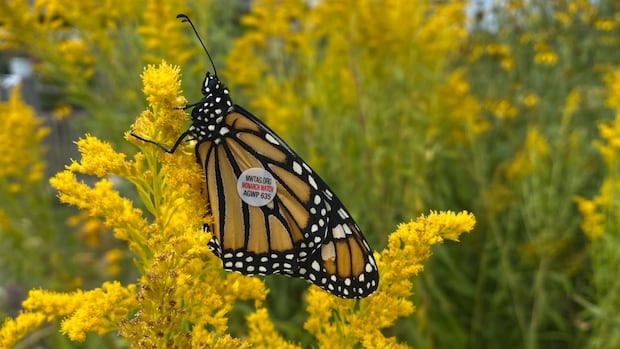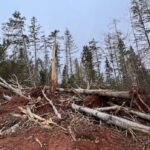PEIMonarch butterflies have dropped sharply on P.E.I. this year, likely because of the dry summer conditions across the Island, according to a local environmental group.P.E.I. environmental group reports butterfly tagging down to just 27 from 400 last yearThinh Nguyen · CBC News · Posted: Sep 26, 2025 10:00 AM EDT | Last Updated: 5 hours agoButterflies are monitored by placing a tag on the centre of the wing. (Submitted by Tracy Brown)Monarch butterflies have dropped sharply on P.E.I. this year, likely because of the dry summer conditions across the Island, according to a local environmental group.The Bedeque Bay Environmental Management Association (BBEMA) has monitored monarchs migrating to P.E.I. for about a decade through two programs.One of them, Monarch Watch, involves tagging butterflies when they arrive in late June and before they fly south for the winter in late summer or fall. The tags are tiny stickers with codes linking each butterfly to the group and its release location.BBEMA’s climate change co-ordinator, Kiley Kitts, said last year the group tagged more than 400 monarchs — but this year, just 27.”It is quite a low number,” Kitts told CBC’s Island Morning. “We do believe that that is because of the drought that we’ve seen this year.”A very dry yearThe federal government listed monarchs as an endangered species under the Species at Risk Act nearly two years ago.Monarchs rely on milkweed to breed. According to Environment and Climate Change Canada, it’s the only plant where monarchs lay their eggs, usually one at a time on the underside of a leaf, and the only plant monarch caterpillars will feed on.BBEMA executive director Tracy Brown said the only native milkweed species on P.E.I. is swamp milkweed, which needs consistently moist soil and does not tolerate drought well.”This year it was very dry…. When we got into July and August, we were actually losing the blooms on the milkweed, so the nectar and the potential source there was drying up,” Brown said.”Every year we collect native milkweed seeds, which we distribute to communities. So this year, our seed collection is quite down because the seed pods would not just stabilize enough to produce a lot of seeds.”Kiley Kitts, left, climate change co-ordinator with the Bedeque Bay Environmental Management Association, and the group’s executive director, Tracy Brown, say they have noticed monarch butterfly numbers plummeting on P.E.I. this year. (Thinh Nguyen/CBC)Kitts said in some natural milkweed sites, the impact of the dry conditions was visible. Caterpillars appeared dry and deflated.Looking ahead, the group plans to continue working with farmers, rural residents and private landowners to create monarch-friendly habitats along fields, ditches and edges of property.”We do promote the planting, obviously, of our native milkweed,” Brown said. “We don’t really encourage people to plant common milkweed because it’s potentially invasive.” Kitts added that another step to support monarchs next year will be replacing some milkweed plants using seeds from the group’s seed bank.Monitoring butterfly healthBBEMA also runs Project Monarch Health, a partnership with the University of Georgia that monitors the parasite Ophryocystis elektroscirrha, which can disrupt caterpillar development.The program began last year and involves rubbing a small sticker on the abdomen of each butterfly to collect a scale sample for microscope testing.Last year, BBEMA sent samples taken from the butterflies’ abdomens to the University of Georgia to test for a parasite. None were found to be infected. (Submitted by Tracy Brown)Kitts said none of the 120 butterflies tested last year were affected by the parasite.”We are fortunate, especially here in the Northern Hemisphere, because our milkweed is able to die back every year. There’s no chance of the parasite… living on the leaves,” she said.”Whereas in some warmer places, especially in Florida, if the milkweed kind of continues to bloom and continues to grow, that parasite never has the chance to kind of die back.”With files from Island Morning
Monarch butterfly numbers plunge on Prince Edward Island after dry summer












